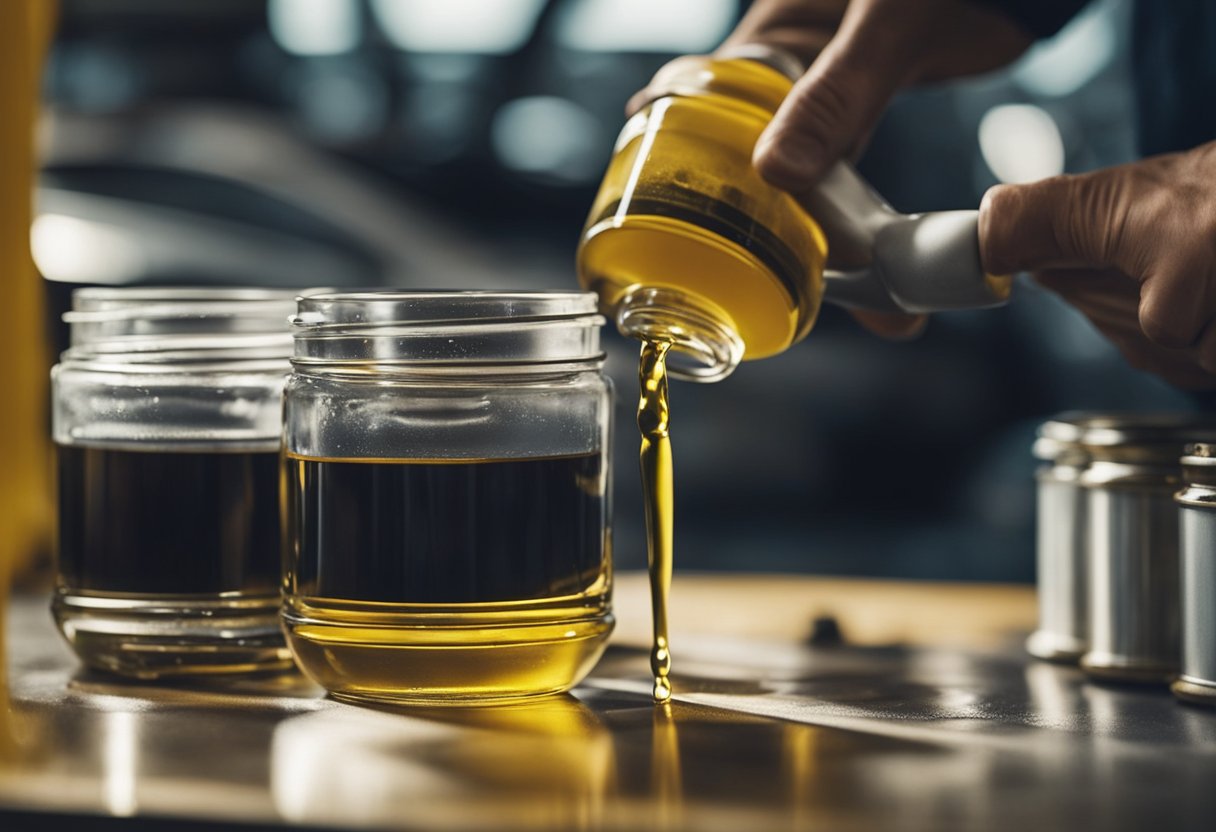Linseed oil has been used for centuries as a natural wood finish, but did you know it can also be used on car paint? Linseed oil is a versatile oil that can protect and enhance the natural color and shine of your car paint. It can also be used to bring out a patina shine on older cars without the need for a clear coat.
Understanding linseed oil is crucial before applying it to your car paint. There are two types of linseed oil: raw and boiled. Raw linseed oil takes a long time to dry and can leave a sticky residue on your car paint. Boiled linseed oil, on the other hand, has been treated with solvents to speed up the drying process and create a more durable finish.
Before applying linseed oil to your car paint, it’s important to properly prepare the surface. This includes washing and drying your car thoroughly and removing any wax or polish. You should also test a small area first to ensure that the linseed oil doesn’t react negatively with your car paint.
Key Takeaways
- Linseed oil is a versatile oil that can be used to protect and enhance car paint.
- Boiled linseed oil is the best option for car paint as it dries faster and creates a more durable finish.
- Proper preparation of the car paint surface is crucial before applying linseed oil.
Understanding Linseed Oil
As an automotive enthusiast, I have always been interested in finding the best ways to protect and enhance the paint on my car. One of the most popular methods I have come across is using linseed oil. In this section, I will explain what linseed oil is, its properties, and how it can be used on car paint.
Raw vs Boiled Linseed Oil
Linseed oil is a natural oil that is extracted from flax seeds. There are two types of linseed oil: raw and boiled. Raw linseed oil is unprocessed and has a slow drying time, which makes it ideal for use in oil paintings. On the other hand, boiled linseed oil is heated and treated with chemicals, which makes it dry faster and more suitable for use in woodworking and as a protective coating for metal surfaces.
Properties of Linseed Oil
Linseed oil is a versatile substance that has several properties that make it ideal for use on car paint. It is a natural product that is non-toxic and environmentally friendly. It is also a drying oil, which means that it will harden and dry over time when exposed to air. This property makes it an ideal coating for car paint, as it forms a protective layer that can help prevent damage from UV rays, dirt, and other environmental factors.
Linseed oil is also resistant to water, which makes it ideal for use on car paint that is exposed to rain and other forms of moisture. It is also a good lubricant, which means that it can help reduce friction and wear on moving parts in the car’s engine.
Linseed Oil and Car Paint
When applied correctly, linseed oil can help protect and enhance the paint on a car. It is important to note that linseed oil should only be applied to clean and dry surfaces. It is also important to use boiled linseed oil, as raw linseed oil can take a long time to dry and may not provide adequate protection.
To apply linseed oil to car paint, it is best to use a clean cloth or brush. The oil should be applied in thin layers and allowed to dry completely between coats. It is important to avoid applying too much oil, as this can lead to a sticky and uneven finish.
In conclusion, linseed oil is a natural and environmentally friendly substance that can be used to protect and enhance the paint on a car. It is important to use boiled linseed oil and to apply it correctly to ensure that it provides adequate protection.
Preparation Process
https://www.youtube.com/watch?v=mEyg_D1EG0w&embed=true
When it comes to using linseed oil on car paint, proper preparation is crucial for achieving optimal results. Here are the steps I follow to ensure that the car surface is clean, dry, and ready for the application of linseed oil:
Cleaning the Car Surface
First, I start by cleaning the car surface with a mild soap and water solution. I use a soft cloth to gently scrub the surface, being careful not to scratch the paint. I pay special attention to any areas with dirt or grime buildup, making sure to remove it completely. Once I have thoroughly cleaned the surface, I rinse it off with water and dry it with a clean, dry cloth.
Drying and Sanding
Next, I allow the car surface to dry completely. It is important to make sure that there is no moisture left on the surface before applying linseed oil. Once the surface is dry, I use a fine-grit sandpaper to lightly sand the surface. This helps to remove any imperfections or rough spots on the paint surface and allows the linseed oil to adhere better.
Applying Mineral Spirits
Before applying the linseed oil, I mix it with mineral spirits. The ratio of mineral spirits to linseed oil depends on the desired result, but I typically use a ratio of one part mineral spirits to four or six parts linseed oil. I apply the mixture to the car surface using a soft cloth or brush, making sure to apply a thin layer. I allow the first coat to dry completely before applying another.
By following these steps, I can ensure that the car surface is clean, dry, and ready for the application of linseed oil. The result is a glossy, protected finish that can help to extend the life of the car’s paint.
Application of Linseed Oil
https://www.youtube.com/watch?v=HD7AvQZoYcU&embed=true
When it comes to applying linseed oil on car paint, there are a few things to keep in mind to ensure a smooth and effective application. Here are some tips to follow:
Using the Right Tools
To apply linseed oil on car paint, you will need a brush. A natural bristle brush is recommended as it will provide a smooth and even application. Synthetic brushes tend to leave brush marks and can be difficult to clean.
Applying a Thin Layer
When applying linseed oil on car paint, it’s important to apply a thin layer. This will ensure that the oil is absorbed into the paint and doesn’t leave any residue. Too much oil can also attract dirt and dust, which can damage the paint over time.
To apply the oil, dip the brush into the linseed oil and wipe off any excess oil on the side of the container. Then, apply the oil in long, even strokes, working in small sections at a time.
Drying Time
After applying the linseed oil, it’s important to let it dry completely before applying another coat or exposing the car to any moisture. The drying time can vary depending on the temperature and humidity, but it’s generally recommended to wait at least 24 hours before applying another coat or exposing the car to any moisture.
In conclusion, applying linseed oil on car paint can be a great way to protect and enhance the paint’s appearance. By using the right tools, applying a thin layer, and allowing enough drying time, you can ensure a smooth and effective application.
Benefits and Drawbacks
https://www.youtube.com/watch?v=BLHJ38MInF0&embed=true
Advantages of Linseed Oil
As a finishing agent, linseed oil can provide a glossy and vibrant appearance to your car’s paint. It can also enhance the natural color of your car’s paint, making it more attractive. Linseed oil is also known for its ability to preserve the elasticity of the paint, which can help protect the paint from cracking or peeling over time.
One of the main benefits of using linseed oil on your car’s paint is that it can provide a durable finish, protecting it from dirt and moisture damage. This can help extend the life of your car’s paint and save you money on repainting costs in the long run.
Potential Issues
While linseed oil has many benefits, there are also some potential drawbacks to consider. One of the main issues with linseed oil is that it can take a long time to dry. In some cases, it can take up to two weeks for the oil to fully cure. This can be a problem if you need to use your car in the meantime or if you live in an area with high humidity.
Another potential issue with linseed oil is that it may not be suitable for all types of car paint. Some car paints may not be able to absorb the oil properly, which can result in an uneven or streaky finish. It’s important to test the oil on a small, inconspicuous area of your car’s paint before applying it to the entire surface.
In addition, linseed oil may not provide the same level of protection as other types of wax or sealant products. While it can help protect your car’s paint from dirt and moisture, it may not be as effective at preventing scratches or other types of damage.
Overall, linseed oil can be a great option for preserving the appearance of your car’s paint and protecting it from damage. However, it’s important to weigh the potential benefits and drawbacks before deciding whether to use it on your car.
Maintenance and Care
https://www.youtube.com/watch?v=3-TRxF5z5kE&embed=true
Taking care of your car’s paint job is essential to maintain its shine and protect it from the elements. Linseed oil can be a great way to protect your car’s paint, but it’s not a substitute for regular maintenance and care. Here are some tips on how to keep your car looking great:
Regular Cleaning
Regular cleaning is essential to prevent dirt and grime from building up on your car’s paint. Use a mild soap and water to clean your car, and avoid using harsh chemicals or abrasive materials that can scratch the surface. After cleaning, use a soft cloth or chamois to dry the car thoroughly.
Dealing with Scratches
Scratches can be a common problem for car owners, but they don’t have to be a permanent blemish on your car’s paint. If you notice a scratch, try using a scratch remover or rubbing compound to buff it out. If the scratch is too deep, you may need to touch up the paint or seek professional help.
Reapplication Process
Linseed oil can last for years on your car’s paint, but it will eventually wear off. When it’s time to reapply the oil, make sure to follow the manufacturer’s instructions carefully. Clean the surface of the car thoroughly and allow it to dry completely before applying the oil. Apply the oil in thin layers, and let each layer dry completely before applying another. Use a soft cloth or brush to apply the oil, and avoid using abrasive materials that can scratch the surface.
By following these tips, you can help protect your car’s paint job from the damaging effects of water, rain, sun, dirt, and other elements. With proper maintenance and care, your car’s paint can look great for years to come.
Safety Considerations
As with any chemical, there are safety considerations to keep in mind when using linseed oil on car paint. Here are a few things to keep in mind:
Combustion Risk
Linseed oil is highly flammable and can ignite spontaneously if not handled properly. Therefore, it is important to dispose of any rags or other materials that have come into contact with linseed oil properly. These materials should be placed in a metal container with a tight-fitting lid and disposed of according to local regulations.
Use of Gloves
Linseed oil can be harmful if it comes into contact with skin, so it is important to wear gloves when handling it. Nitrile gloves are a good choice because they are resistant to chemicals and will not break down when exposed to linseed oil.
In addition to wearing gloves, it is also a good idea to wear long sleeves and pants to protect your skin from any splatters or spills. If linseed oil does come into contact with your skin, wash the affected area thoroughly with soap and water.
By following these safety considerations, you can ensure that your use of linseed oil on car paint is both effective and safe.
Conclusion
In conclusion, using linseed oil on car paint can be a great way to protect and maintain the paint job of your vehicle. Linseed oil is an all-natural solution that can form a tough and durable layer on the surface of your car, protecting it from dirt and moisture damage.
One of the benefits of using linseed oil is that it is a cost-effective solution compared to other car paint protectants. It is also very easy to apply and can be done at home without any professional help.
However, it is important to note that linseed oil can take a long time to dry, which can be a drawback for some car owners. It is also important to use boiled linseed oil instead of raw linseed oil, as the latter can cause discoloration of the car paint.
Overall, using boiled linseed oil on car paint can be a great way to protect and maintain the paint job of your vehicle. It is important to follow the proper application process and to use boiled linseed oil to avoid any potential drawbacks.
Frequently Asked Questions
Can linseed oil be used as an undercoat for car paint?
Yes, linseed oil can be used as an undercoat for car paint. It provides a protective layer that helps to prevent rust and corrosion. However, it is important to note that linseed oil takes a long time to dry, so it may not be the best choice for a quick job.
What are the effects of linseed oil on car paint?
Linseed oil can have a number of positive effects on car paint. It can help to protect the paint from the elements, prevent rust and corrosion, and give the paint a nice shine. However, if not applied correctly, it can also cause the paint to blister or peel.
How can I remove linseed oil from my car’s painted surface?
If you need to remove linseed oil from your car’s painted surface, you can use a degreaser or a solvent-based cleaner. Be sure to follow the manufacturer’s instructions carefully, and test the cleaner on a small, inconspicuous area first to make sure it does not damage the paint.
Is it safe to apply boiled linseed oil on car metal patina?
Yes, it is safe to apply boiled linseed oil on car metal patina. It will help to protect the metal from rust and corrosion, and give it a nice shine. However, it is important to note that linseed oil takes a long time to dry, so you should be prepared to wait before using your car.
What is the difference between Patina Sauce and linseed oil?
Patina Sauce is a commercial product that is designed specifically for use on car metal patina. It contains a blend of oils, solvents, and other ingredients that help to protect the metal from rust and corrosion, and give it a nice shine. Linseed oil, on the other hand, is a natural oil that can be used on a variety of surfaces, including car paint and metal patina.
Can I paint my car after applying linseed oil?
It is possible to paint your car after applying linseed oil, but it is not recommended. Linseed oil takes a long time to dry, and it can interfere with the adhesion of the paint. If you need to paint your car, it is best to remove all traces of linseed oil first.

Hi, I’m Sal Muller of Tooltrip.com. My DIY experience led me to understand essential power tools for home projects. Tooltrip.com guides enthusiasts and professionals in choosing right tools for any job. I provide concise top tool reviews for easier, efficient DIY.






